Not herons but rather more closely related to spoonbills, they have strikingly red bill and legs.
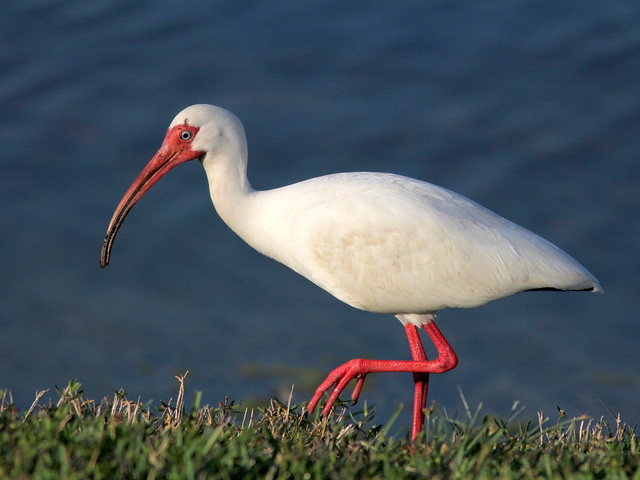
During mating season, around the middle of winter, the males squabble to establish dominance.
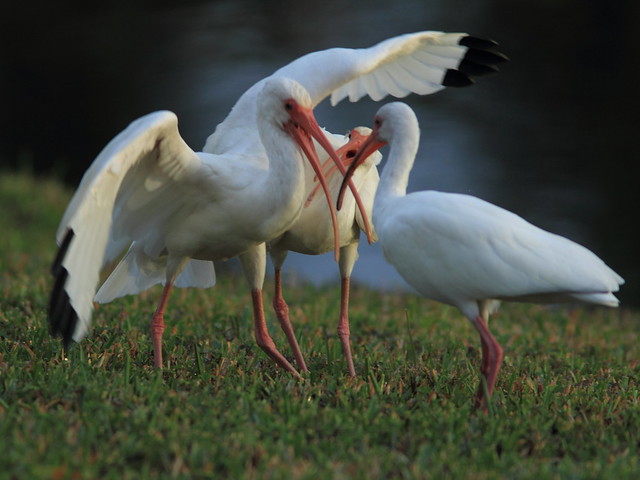
Tactile feeders, the ibis probes into the mud and clamps down upon prey. This one just caught a crayfish.
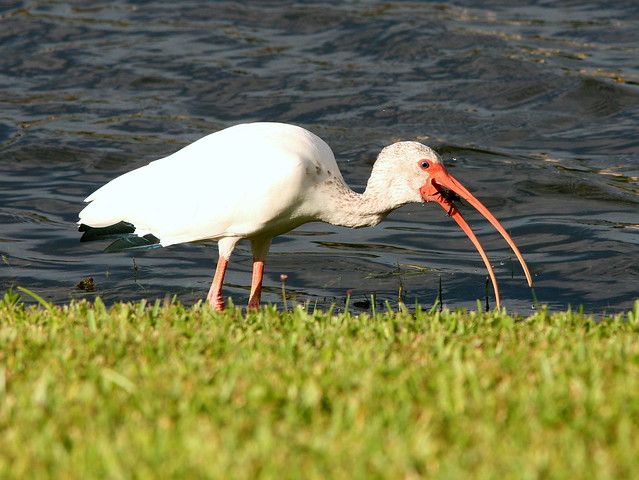
Egrets are also common. Great Egrets might be seen at any time. They are sight feeders and either wait patiently or stalk for prey such as small fish, crustaceans and insects.
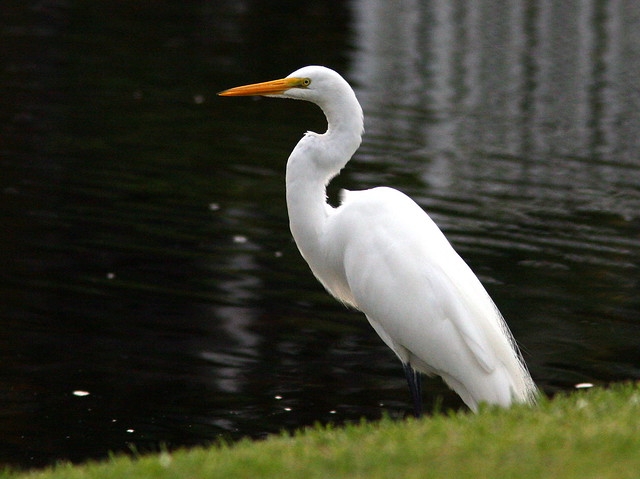
They are quite wary, and I find it difficult to obtain a closeup. Note the long bright orange-yellow bill and all-black legs.
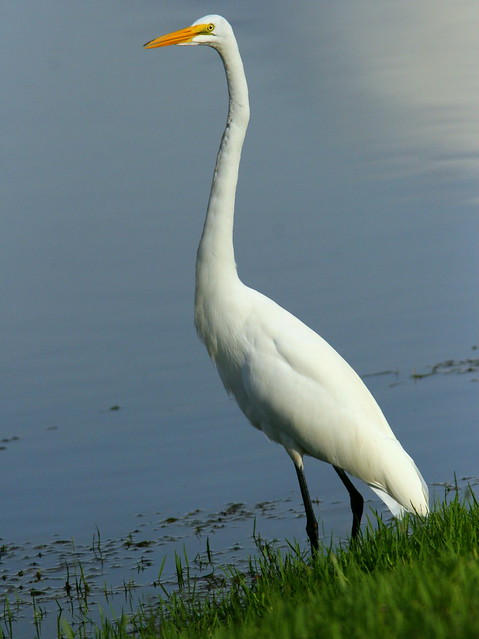
The smaller Snowy Egret appears sporadically. A more restless feeder, it quickly traverses the shoreline in search of food. Its bill is black and its "golden slippers" contrast with mostly black legs. It startles prey by stirring the water with its yellow feet.
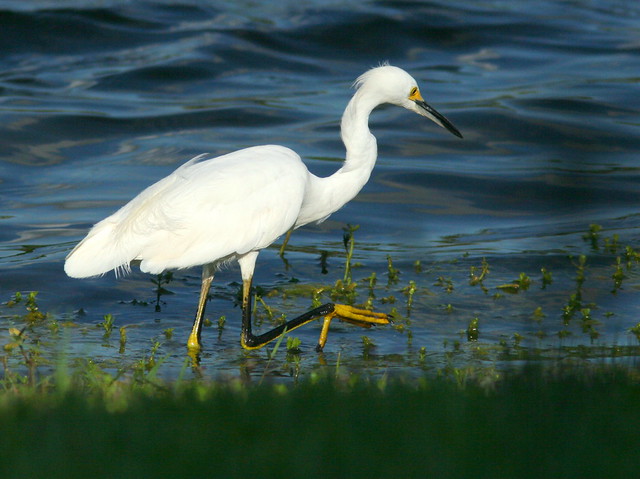
Even smaller is the Cattle Egret, distinguished by its short yellow bill and dark legs. Rather than hunting in the water, it searches our garden for insects and lizards.
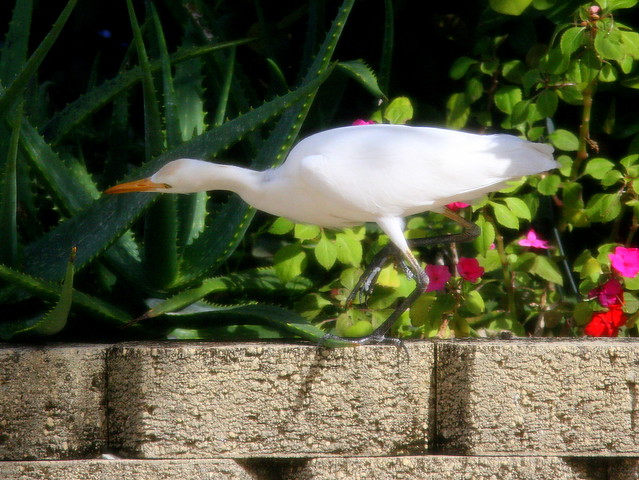
The Cattle Egret develops rusty plumes on its head and breast during breeding season.
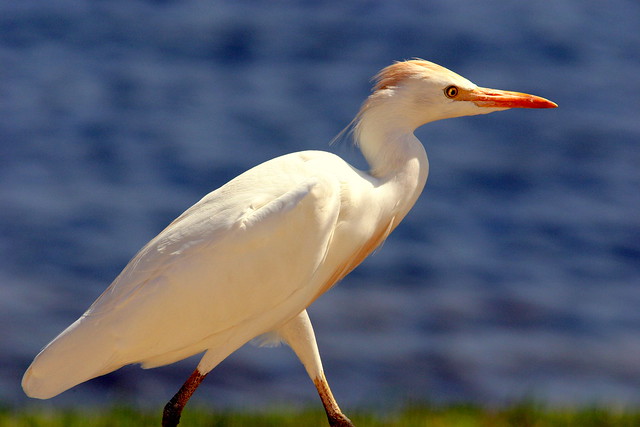
We usually have Little Blue Herons on the lake, but most are dark adults. During their first year they are white, and we must take a closer look to postively identify them. Deliberate hunters, they seem to be near-sighted as they walk slowly with their bills almost touching the water (or the grass, as this one is after a dragonfly). Greenish legs and a light bill with a dark tip are distinctive features.
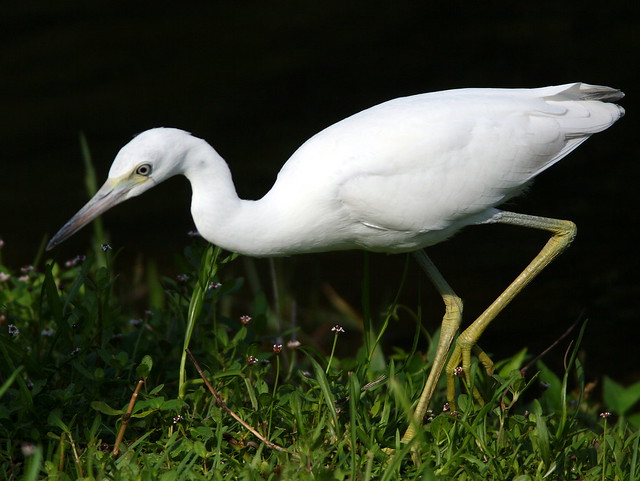
Less common, especially in recent years, is the Wood Stork. A tactile feeder, it slowly moves along with half-open bill. Like the Snowy Egret, it stirs the water with its feet, which are bubble-gum pink.
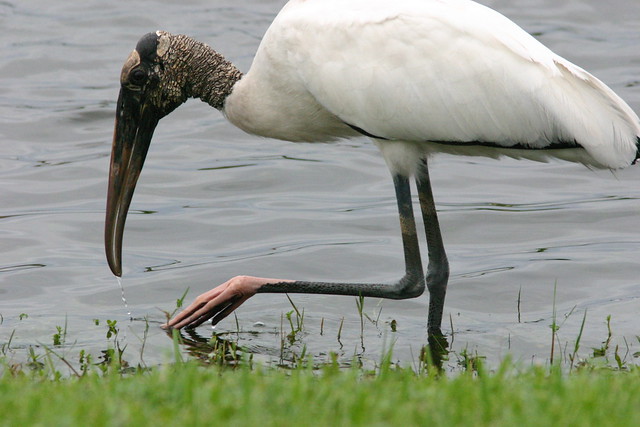
Rare indeed is the visitor which occasioned this post. Look closely and compare it with the white waders described above.
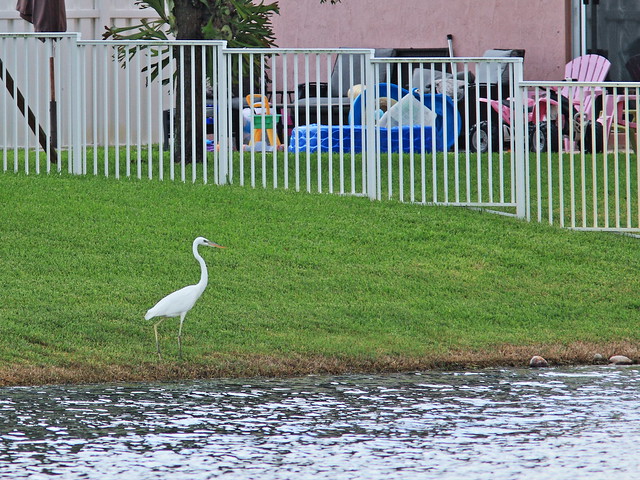
It is a "Great White Heron," a subspecies of the Great Blue Heron. Admittedly, I almost passed it off as a Great Egret when I first saw it across the lake. However it seemed bulkier and had a habit of roosting in one spot for a long time, even up to an hour, so I took a closer look. This was my first photo, which confirmed my suspicions.
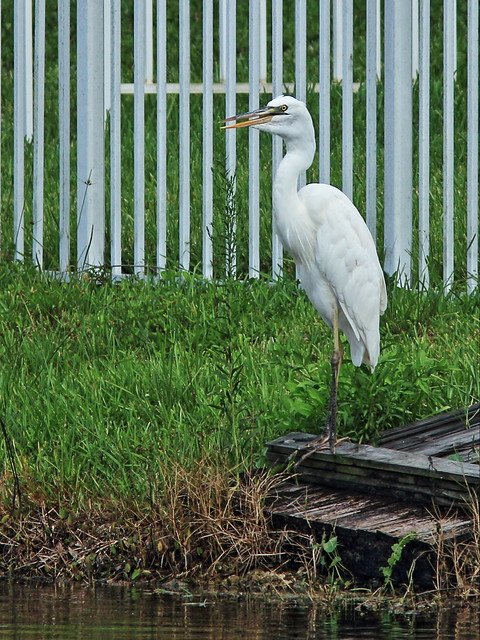
Known to breed in Cuba and some of the Caribbean Islands as well as the Yucatan Peninsula and on islands off the coast of Venezuela, the Great White Heron's North American range is almost exclusively limited to the Florida Keys and the tip of the Florida south of Miami.
Its upper mandible is dark, contrasting with the orange lower bill, quite identical to the common "blue" form of the Great Blue Heron.This bird's thighs are light, and its lower legs are darker but not black.
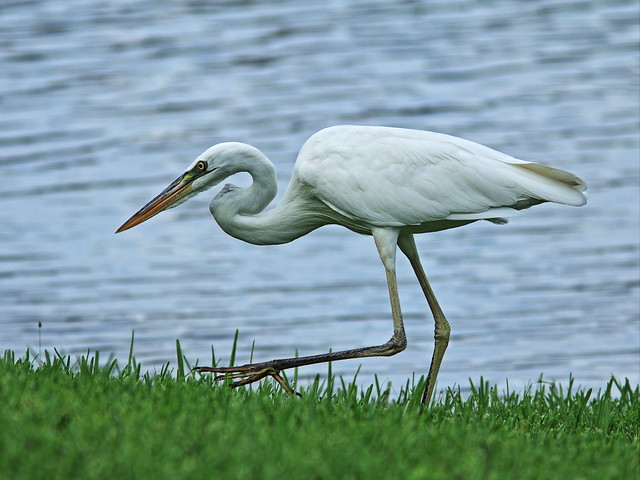
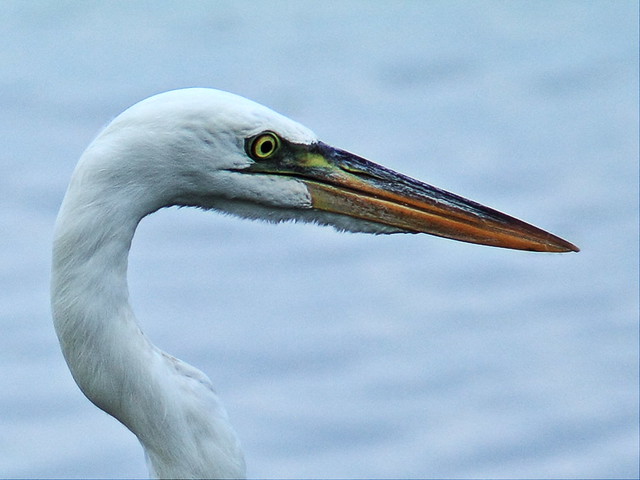
This bird was earlier considered to be a variant color morph of the nominate Great Blue Heron (Ardea herodias herodias), but is actually a distinct subspecies, Ardea herodias occidentalis. The blue and white subspecies occasionally interbreed.
Since Great Egrets are sometimes misidentified as Great White Herons, I had the unusual opportunity to photograph both individually from the same distance, walking across a lawn on the opposite side of the lake. Both photos were taken at a range of 140 meters and nearly the same angle. They exhibit the larger size and more robust body of the Great White Heron.
Great White Heron at 140 meters:

Great Egret at 140 meters:

The Great White Heron prefers coastal waters and rarely ventures north of its habitual range, but has been documented along the Atlantic into New England and even Canada. Inland sightings are quite rare. Our home is 18 miles away from the ocean, and this was the first one to visit our yard.
The Great White Heron spent much time on our back lawn, remaining for three days straight, then after a two day absence it reappeared. It was so close that even after I backed away I could not fit the entire bird in the video frame!
Great photos and interesting to learn a little more about these beautiful birds. Thank you and have a great weekend.
ReplyDeletewhat an awesome post, ken! the sighting was rare and remarkable, but the way you put the comparisons together was really well done, too. GREAT (blue or white) job! :)
ReplyDeleteAn amazing series and loved seeing the video!
ReplyDeleteGreat shots, love especially the second foto.greeting from Belgium
ReplyDeletehttp://louisette.eklablog.com
Awesome....Love the close up of the ibis face. And all your bird photos.
ReplyDeleteReally cool to have him in your backyard. We had one for about a month at Fort Desoto.
ReplyDeleteHow amazing to have all these beautiful birds in your backyard. Great shots!
ReplyDeleteA superb mix of fabulous images and helpful ID facts. Thanks for a very interesting post Ken.
ReplyDeleteThe white Ibis and the Wood Stork are fascinating birds, beautiful photos.
ReplyDeleteKen awesome post. The White Ibis are one of my favorite birds. I love the egrets too, the wood stork is a cool looking bird. Great shots!
ReplyDeleteBeautiful and informational series. I love seeing all these big white birds.
ReplyDeleteFabulous photos and interesting information on these birds. Thank you for sharing!
ReplyDeleteWhat a fantastic post! Love learning about the differences. That wood stork is terribly interesting! I'd never heard of it before. And my favorite I think is the young small blue heron. Great photos and video too!
ReplyDeleteA great selection of white waders ken and an object leeson in how to separately ID them. Gosh , you have so many there in Florida and I must admit I would struggle to separate the Great White Egret and the Great Heron.
ReplyDeleteI can'teven imagine having a Catlle Egret as a garden bird but they do seem to be the most confiding of all the herons I've seen.
These are such amazing photos! You have a lot of variety right there in your own back yard. We love living in Florida and seeing the variety of birds....never seen the Great White Heron though! Wonderful sighting. We'll have to travel farther South to see that one!
ReplyDeleteAs I posted here in the comment box over the weekend that I love the Ibis. Your photography is outstanding Ken.
ReplyDeleteAnd, thanks for stopping by Hootin' Anni's today with the sword in the stone post. Much appreciated.
The Ibis and heron are so beautiful. Thanks so for sharing.
ReplyDeleteFabulous tutorial, Ken! A Great White Heron in the back yard - now that's pretty special! Another great post.
ReplyDeleteThanks for the reminder of beautiful Florida. I love the ibis in breeding colors (one of the neat things we saw the years we stayed later in the season --- as we hope to do again this coming one). I was so mad at myself after we got home from the Keys a couple of years ago because I'm pretty sure we saw that white heron -- we were talking about how big the great egrets seemed in one place ... and then later read about the white heron. Missed opportunity.
ReplyDeleteThank you for showing him so well in comparison to the other white beauties. And
PS: thanks too for not rubbing it in about seeing MT Denali ;>).... I loved your post about staying in that cabin at Kaneesha.